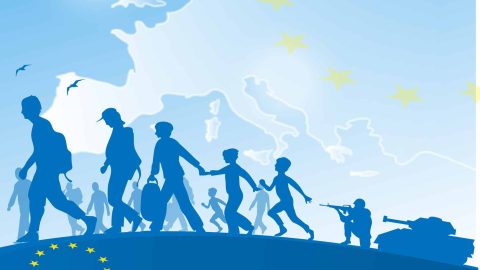The current refugee crisis is immense. Estimates expect more than a million people to apply for asylum this year in the European Union; i.e. we are talking about 0.2% in terms of total population. This would suggest that the immigration can be handled if all the countries cooperate.
Structural whip
Much like other crises in the past, the current one highlights the structural weaknesses of the European Union. The necessary institutions necessary to ensure the long-term existence of the Union are not yet in place although much has been achieved already. The crisis works like a structural whip, forcing the EU to institutionalise coordination on an ad-hoc basis.
In the short term
The immediate challenges are relatively easily solved. Distribution, registration, (legal) transport, shelter, food and water, and administration have to be sorted out and provided. If even that is beyond acceptance, chaos and a deterioration of the humanitarian crisis are looming on the horizon. There is no escaping a comprehensive and coordinated approach. Overall and in the long run, this is about keeping the humanitarian “costs” as low as possible.
In the medium term
The medium-term challenges are significantly more difficult. They affect mainly the immigrants’ willingness to integrate, and the willingness of the local population to aid said integration. Only if immigrants are integrated – as opposed to assimilated – successfully will short term costs turn into long-term benefit in terms of monetary units. Here, too, we need an overall package that contains investment in human capital (education, language abilities, skills), healthcare, public services, and living space. The long-term benefit is based on the comparably low average age of the migrants and the positive net tax effect (in a long-term perspective). This would help mitigate the demographic problem of the EU, where the ratio of retired people to working population has been growing rapidly.
Benefits
Therefore an active approach to the refugee crisis would be beneficial from numerous points of view. It limits humanitarian costs. It represents investment in future consumers. It increases the working population. From an economic point of view, stimulus generated on the spending side meets an increase of supply of labour force. In the medium term this supports both total output and the public budget (albeit only marginally).
Risks
Of course there are risks, mainly with regard to the potential decline in social, political, and governmental cohesion. This will be more profound the less comprehensively a strategy is formed and implemented in dealing with the refugee crisis. Anti-immigration and anti-EU parties would be picking up support.
Conclusion
In order to mitigate human hardships and to cap demagogical forces, we will all have to work together. We are reminded that the basic human rights apply always, even if they are not being acted upon. Also, migration will come with positive human effects in the medium term.
Legal disclaimer
This document is an advertisement. Unless indicated otherwise, source: Erste Asset Management GmbH. The language of communication of the sales offices is German and the languages of communication of the Management Company also include English.
The prospectus for UCITS funds (including any amendments) is prepared and published in accordance with the provisions of the InvFG 2011 as amended. Information for Investors pursuant to § 21 AIFMG is prepared for the alternative investment funds (AIF) administered by Erste Asset Management GmbH pursuant to the provisions of the AIFMG in conjunction with the InvFG 2011.
The currently valid versions of the prospectus, the Information for Investors pursuant to § 21 AIFMG, and the key information document can be found on the website www.erste-am.com under “Mandatory publications” and can be obtained free of charge by interested investors at the offices of the Management Company and at the offices of the depositary bank. The exact date of the most recent publication of the prospectus, the languages in which the fund prospectus or the Information for Investors pursuant to Art 21 AIFMG and the key information document are available, and any other locations where the documents can be obtained are indicated on the website www.erste-am.com. A summary of the investor rights is available in German and English on the website www.erste-am.com/investor-rights and can also be obtained from the Management Company.
The Management Company can decide to suspend the provisions it has taken for the sale of unit certificates in other countries in accordance with the regulatory requirements.
Note: You are about to purchase a product that may be difficult to understand. We recommend that you read the indicated fund documents before making an investment decision. In addition to the locations listed above, you can obtain these documents free of charge at the offices of the referring Sparkassen bank and the offices of Erste Bank der oesterreichischen Sparkassen AG. You can also access these documents electronically at www.erste-am.com.
Our analyses and conclusions are general in nature and do not take into account the individual characteristics of our investors in terms of earnings, taxation, experience and knowledge, investment objective, financial position, capacity for loss, and risk tolerance. Past performance is not a reliable indicator of the future performance of a fund.
Please note: Investments in securities entail risks in addition to the opportunities presented here. The value of units and their earnings can rise and fall. Changes in exchange rates can also have a positive or negative effect on the value of an investment. For this reason, you may receive less than your originally invested amount when you redeem your units. Persons who are interested in purchasing units in investment funds are advised to read the current fund prospectus(es) and the Information for Investors pursuant to § 21 AIFMG, especially the risk notices they contain, before making an investment decision. If the fund currency is different than the investor’s home currency, changes in the relevant exchange rate can positively or negatively influence the value of the investment and the amount of the costs associated with the fund in the home currency.
We are not permitted to directly or indirectly offer, sell, transfer, or deliver this financial product to natural or legal persons whose place of residence or domicile is located in a country where this is legally prohibited. In this case, we may not provide any product information, either.
Please consult the corresponding information in the fund prospectus and the Information for Investors pursuant to § 21 AIFMG for restrictions on the sale of the fund to American or Russian citizens.
It is expressly noted that this communication does not provide any investment recommendations, but only expresses our current market assessment. Thus, this communication is not a substitute for investment advice.
This document does not represent a sales activity of the Management Company and therefore may not be construed as an offer for the purchase or sale of financial or investment instruments.
Erste Asset Management GmbH is affiliated with the Erste Bank and austrian Sparkassen banks.
Please also read the “Information about us and our securities services” published by your bank.



